- Accueil
- Pages cachées
- 24 SEPTEMBRE 2023 NEWS
24 SEPTEMBRE 2023 NEWS
INSTITUT SUPERIEUR D'ANTHROPOLOGIE
INSTITUT OF ANTHROPOLOGY
COURS ONLINE – COURS A DISTANCE
INSCRIPTIONS : SEPTEMBRE 2023
REGISTER NOW
THAILANDE –  Si Thep - Thailand's ancient ruined town of Si Thep, a 1,500-year-old complex of temples, monasteries and other buildings, was added to UNESCO's world heritage list on Tuesday. Archaeologists date the statues and buildings of Si Thep, built by the Dvaravati civilization, to between 1,500 and 1,700 years ago. At its peak the town was a thriving cultural and trading metropolis that celebrated Hindu and Buddhist beliefs.
Si Thep - Thailand's ancient ruined town of Si Thep, a 1,500-year-old complex of temples, monasteries and other buildings, was added to UNESCO's world heritage list on Tuesday. Archaeologists date the statues and buildings of Si Thep, built by the Dvaravati civilization, to between 1,500 and 1,700 years ago. At its peak the town was a thriving cultural and trading metropolis that celebrated Hindu and Buddhist beliefs.
Thailand's ancient town of Si Thep added to world heritage list (phys.org) .
EGYPTE – 
 Thonis Heracleion - The joint Egyptian-French archeological mission between the Supreme Council of Antiquities and the European Institute of Marine Archeology uncovered the temple of the goddess Aphrodite from the 5th century BC, along with a number of archeological findings belonging to the temple of Amun Jurib, during underwater excavations in the sunken city of Thonis Heracleion in Abu Qir Bay in Alexandria. Mustafa Waziri, Secretary-General of the Supreme Council of Antiquities explained that the mission found inside the temple bronze and ceramic artifacts imported from Greece, in addition to the remains of buildings supported by wooden beams. Frank Judeo, president of the European Institute of Marine Archeology noted that the team also found the area where offerings and valuable items were stored at the Western Temple of Amun, including a set of gold ornaments-made earrings in the shape of a lion's head, an agit's eye, a prayer, and alabaster utensil that were used to store perfumes and cosmetic ointments, in addition to a set of ritual items made in silver that were used in religious and funerary events, as well as a votive hand grip in limestone and a bronze duck-shaped pitcher. Islam Salim, Director General of the Sunken Antiquities Department said that the sunken city of Thonis Heracleion is located 7 km from the coast of Abu Qir, and was considered the largest port of Egypt on the Mediterranean coast before Alexander the Great founded the city of Alexandria in 331 BC.
Thonis Heracleion - The joint Egyptian-French archeological mission between the Supreme Council of Antiquities and the European Institute of Marine Archeology uncovered the temple of the goddess Aphrodite from the 5th century BC, along with a number of archeological findings belonging to the temple of Amun Jurib, during underwater excavations in the sunken city of Thonis Heracleion in Abu Qir Bay in Alexandria. Mustafa Waziri, Secretary-General of the Supreme Council of Antiquities explained that the mission found inside the temple bronze and ceramic artifacts imported from Greece, in addition to the remains of buildings supported by wooden beams. Frank Judeo, president of the European Institute of Marine Archeology noted that the team also found the area where offerings and valuable items were stored at the Western Temple of Amun, including a set of gold ornaments-made earrings in the shape of a lion's head, an agit's eye, a prayer, and alabaster utensil that were used to store perfumes and cosmetic ointments, in addition to a set of ritual items made in silver that were used in religious and funerary events, as well as a votive hand grip in limestone and a bronze duck-shaped pitcher. Islam Salim, Director General of the Sunken Antiquities Department said that the sunken city of Thonis Heracleion is located 7 km from the coast of Abu Qir, and was considered the largest port of Egypt on the Mediterranean coast before Alexander the Great founded the city of Alexandria in 331 BC.
Goddess Aphrodite Temple Unearthed in Sunken City in Alexandria | Sada Elbalad (see.news)
ESPAGNE – 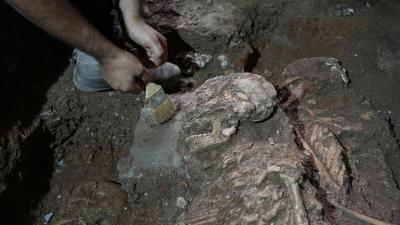 Grenade - Researchers stumbled upon a centuries-old Muslim cemetery during the restoration of a building in Granada, a prominent city in the Andalusia region of southern Spain. Eliminated during the subsequent Catholic monarchs period, the over-700-year Andalusian Islamic rule has left traces now being sought in and around Granada, the former capital of an emirate that reigned between the 13th and 15th centuries and was the last known Muslim state in the Iberian Peninsula. Archaeologist Amjad Suliman, who is conducting research on the Andalusian Islamic civilization, told Anadolu Agency (AA) that they unearthed one of eight Muslim cemeteries in the city during excavations on the grounds of a building in the ancient city center of Granada, in the area known as "Bab al-Fukhareen," or Potters' Quarter. Stating they understood that the human remains belonged to Muslims by inspecting the way they were buried and the objects around them, Suliman added that during the dig, they reached three underground layers of graves, along with many pieces of pottery with Arabic inscriptions similar to those in the Alhambra Palace, which was built in mid-13th century Granada.
Grenade - Researchers stumbled upon a centuries-old Muslim cemetery during the restoration of a building in Granada, a prominent city in the Andalusia region of southern Spain. Eliminated during the subsequent Catholic monarchs period, the over-700-year Andalusian Islamic rule has left traces now being sought in and around Granada, the former capital of an emirate that reigned between the 13th and 15th centuries and was the last known Muslim state in the Iberian Peninsula. Archaeologist Amjad Suliman, who is conducting research on the Andalusian Islamic civilization, told Anadolu Agency (AA) that they unearthed one of eight Muslim cemeteries in the city during excavations on the grounds of a building in the ancient city center of Granada, in the area known as "Bab al-Fukhareen," or Potters' Quarter. Stating they understood that the human remains belonged to Muslims by inspecting the way they were buried and the objects around them, Suliman added that during the dig, they reached three underground layers of graves, along with many pieces of pottery with Arabic inscriptions similar to those in the Alhambra Palace, which was built in mid-13th century Granada.
Spain's Granada reveals another Muslim Andalusian cemetery | Daily Sabah
SUEDE – Gotska Sandön - Archaeologists have discovered an Iron Age port on Gotska Sandön, an island and national park in Sweden’s Gotland district. In the spring of 2023, archaeologists found two 2,000-year-old Roman coins on one of the island’s beaches. Archaeologists have now returned to the island and made more thrilling discoveries. These offer more clues about what the site may have been used for 2000 years ago and consist of twenty hearths on the beach where the coins were found. Johan Rönnby, a professor of marine archaeology at Södertörn University, is participating in the dig and describes the site as a type of Iron Age port. This is not a port with quays in the modern sense, but he theorizes that people landed here, pulled up their boats, and formed an encampment. The hearths had been found during previous digs, when poles stuck into the ground emerged blackened with carbon. One of the hearths has now been excavated and dated using the carbon-14 method, showing that the site was in use around 2,000 years ago. It can therefore be linked to the coin finds from around the same date. Researchers are unable to say with certainty what happened here, but Rönnby’s guess is that the site may be linked to the seal hunting, which is known to have taken place. “Seal hunters may have come from the island of Gotland and landed on Sandön to boil seal blubber. This could have been what the hearths were used for, but we don’t yet know – there may be other reasons why the site looks like it does, such as it being a trading post,” said Rönnby. Further excavations will take place over the coming weeks to uncover more clues to the site’s past. In addition to the Roman coins, ceramics were found here a century ago. Rönnby now hopes that they will find more ceramics that the project can analyze.
Iron Age port discovered on Swedish island of Gotska Sandön - Arkeonews
Rep. TCHEQUE – Býčí Skála - Czech scientists, together with a small experimental brewer, have come up with the country’s first “Celtic beer”. Called TauriALE, the recreation of the ancient alcoholic beverage was achieved using laboratory analysis of pollen from an early Celtic burial site in Moravia. In 2020 and 2021, scientists from Charles University in Prague and Palacký University in Olomouc made excavations at the well-known archaeological site of Býčí Skála in the Moravian Karst, which dates back to the Early Iron Age.The site was discovered back in 1867 and is one of the most important cult and burial centres of the Hallstatt people – the early Celtic inhabitants of central Europe. The aim of the excavations was to collect samples of the soil for detailed laboratory analysis, says Zuzana Golec Mírová, one of the members of the team: “We discovered the remains of burial chambers, which were quite common in the Hallstat period and inside those chambers there was soil, as well as organic and botanical remains. We took samples for chemical analysis, but also for pollen analysis, which turned out to be crucial.” The analysis of the pollen, carried out by the Brno Botanical Institute, has revealed traces of millet and various herbs in the samples, which are ingredients that were commonly used by Celts to make beer . “Usually in the prehistorical beer there are ingredients used for the taste and ingredients used for preserving the content. There is meadowsweet or filipendula ulmaria, sage or salvia officinalis and mugwort or Artemisia vulgaris, which make the sour bitter taste of the beer of course.“What was quite unexpected was the discovery of clover, which is quite unusual and isn’t usually used in beer. But then we realised that it's most common pollen found in the honey. So it is possible that this beer was sweetened with honey.” Scientists are convinced that the raw materials for brewing beer were placed in the graves as burial gifts, which was a common practice among the Celts and other ancient peoples.
Scientists make “Celtic beer” using analysis of pollen from burial site | Radio Prague International
TURQUIE – 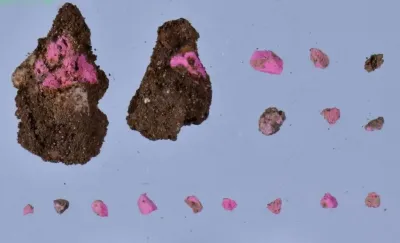
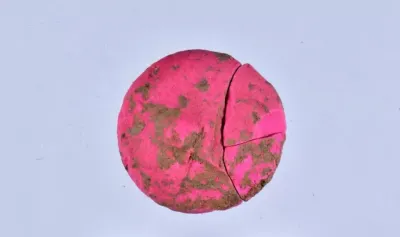 Aizanoi - Archaeologists discovered rare makeup products of 10 different colors and different sorts of hair accessories and jewelry during excavations at the ancient Roman city of Aizanoi in Türkiye’s Kütahya province, Coşkun said they discovered the remnants of a cosmetics and jewelry shop while excavating 2,000-year-old shops in the ancient city’s marketplace. “We found out that the shop sold perfume, jewelry, and makeup products,” he said, adding that they found many perfume bottles, pieces of jewelry, and makeup. The professor noted that they discovered blusher and eye shadows in the excavations. “We know that ancient Romans stored their eyeshadows and blushes in oyster shells and we found numerous oyster shells in the shops we were carrying out excavations in,” Coşkun said. The professor said that archaeologists discovered makeup products of 10 different colors and different sorts of hair accessories and jewelry.
Aizanoi - Archaeologists discovered rare makeup products of 10 different colors and different sorts of hair accessories and jewelry during excavations at the ancient Roman city of Aizanoi in Türkiye’s Kütahya province, Coşkun said they discovered the remnants of a cosmetics and jewelry shop while excavating 2,000-year-old shops in the ancient city’s marketplace. “We found out that the shop sold perfume, jewelry, and makeup products,” he said, adding that they found many perfume bottles, pieces of jewelry, and makeup. The professor noted that they discovered blusher and eye shadows in the excavations. “We know that ancient Romans stored their eyeshadows and blushes in oyster shells and we found numerous oyster shells in the shops we were carrying out excavations in,” Coşkun said. The professor said that archaeologists discovered makeup products of 10 different colors and different sorts of hair accessories and jewelry.
Archaeologists find 2,000-year-old eyeshadow and blush in ancient Roman city of Aizanoi - Arkeonews
TURQUIE –  -Aigai - During the ongoing excavations in the Aigai Ancient City, located near the Yuntdağı Köseler Village of Manisa province in western Türkiye, hundreds of oil lamps were found, the most recent of which is 1800 years old and the oldest of which is 2500 years old. This year’s excavations in the ancient city focused on the Athena temple area, the foundations of which were reached in 2021. Prof. Dr. Yusuf Sezgin in his statement, “The 2023 excavation works began in mid-May and are actively ongoing. Excavations have been carried out intensively in the city since 2004. We have come across a large number of lamps in the excavations. One of the most fundamental needs of human beings is shelter, and the corresponding need is actually for lighting. Illuminating homes during the darkness of the night is a basic requirement. Many oil lamps, especially in a garbage pit we excavated in the city in 2015, were found. These lamps had been broken and damaged, and they had been discarded. After restoring them, we obtained many lamps,” he said. Sezgin continued his remarks by saying, “The fuel used in these lamps is primarily olive oil, which was a fundamental resource in ancient times. Olive oil served two main purposes in antiquity. First, it was used as fuel for lighting in lamps, and second, it was used for body lubrication. It was used less frequently in cooking. These lamps reveal a lot to us. The land of the ancient city is suitable for olive oil cultivation. Besides olive trees, we also encountered a significant presence of pistachio (terebinth) trees in Aigai. Until recent times, there were workshops in many areas near the ancient city that produced pistachio oil. They primarily used pistachio oil in cooking.”
-Aigai - During the ongoing excavations in the Aigai Ancient City, located near the Yuntdağı Köseler Village of Manisa province in western Türkiye, hundreds of oil lamps were found, the most recent of which is 1800 years old and the oldest of which is 2500 years old. This year’s excavations in the ancient city focused on the Athena temple area, the foundations of which were reached in 2021. Prof. Dr. Yusuf Sezgin in his statement, “The 2023 excavation works began in mid-May and are actively ongoing. Excavations have been carried out intensively in the city since 2004. We have come across a large number of lamps in the excavations. One of the most fundamental needs of human beings is shelter, and the corresponding need is actually for lighting. Illuminating homes during the darkness of the night is a basic requirement. Many oil lamps, especially in a garbage pit we excavated in the city in 2015, were found. These lamps had been broken and damaged, and they had been discarded. After restoring them, we obtained many lamps,” he said. Sezgin continued his remarks by saying, “The fuel used in these lamps is primarily olive oil, which was a fundamental resource in ancient times. Olive oil served two main purposes in antiquity. First, it was used as fuel for lighting in lamps, and second, it was used for body lubrication. It was used less frequently in cooking. These lamps reveal a lot to us. The land of the ancient city is suitable for olive oil cultivation. Besides olive trees, we also encountered a significant presence of pistachio (terebinth) trees in Aigai. Until recent times, there were workshops in many areas near the ancient city that produced pistachio oil. They primarily used pistachio oil in cooking.”
Hundreds of oil lamps discovered in Aigai, "the City of Goats" - Arkeonews
ISRAEL – 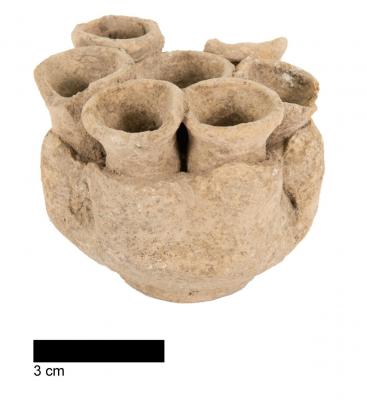
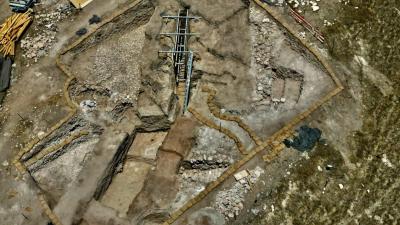 Tel Shimron - A rare and surprisingly well-preserved structure dating back to the Middle Bronze Age some 3,800 years ago was unearthed over the summer at the archaeological site of Tel Shimron, in the Jezreel Valley in northern Israel. Archaeologists excavated a corbelled passageway and large vault built of thousands of unfired mud bricks, the first example of corbelled architecture found in Israel. Corbelling, sometimes referred to as a “false arch,” is an ancient technique in which bricks are stacked progressively inward to create a vaulted ceiling, and was common in ancient Mesopotamia, but had not previously been found in the Southern Levant. Vessels and other artifacts were also found at the site.Only about 500 square meters (5,380 square feet) of Tel Shimron have been uncovered thus far, but it is estimated that the complex’s total size is a massive 200,000 square meters (49 acres), nearly double the size of the much more famous archaeological site at nearby Megiddo. The whole structure was artificially elevated by more than 4 meters (13 feet). Martin told The Media Line that the discoveries date to a time when Shimron was at its largest, “an era of intense urbanization in the region, as well as the development of city-states and the emergence of the Canaanite culture.” Excavations at Tel Shimron began on the southern side of the acropolis, where a tower complex consisting of some 9,000 mud bricks was unearthed. Inside the tower, a 1-meter-wide passageway with walls about 5 meters (16 feet) high was then uncovered. At the entrance to the passageway, researchers found a fully intact “Nahariya Bowl,” a vessel with seven cups that was used for cultic offerings and ceremonies. This vessel helped to date the structure to the Middle Bronze Age.The corbelled vault was found at the end of the passage. From it, a tunnel leads down that continues for a further 2 meters before being blocked by large stones. Removing the stones would risk collapse and danger to the excavation teams and they have been left in place. “The Tel Shimron passageway with a corbelled vault fills an important gap in the history of architecture in this region,” Master said in the press release announcing the find. “The vault is an ancestor to the mud brick radial arch in the gate at Tel Dan and is an extraordinary example of Mesopotamian mud brick technology,” he said. Both the passage and the vault are made of unfired mud bricks, the first such discovery in the Southern Levant region. The researchers said that unfired mud brick structures almost never survive the test of time, making the find particularly exciting.“It’s not like the Romans or Mesopotamians, who fired their bricks,” Martin told The Media Line. “[With mud brick] you just take mud, you dry it in the sun, and that’s your building material.” He said it was most impressive that these simple mud bricks not only held together in such a massive passageway and vaulted structure but that they were so well preserved.
Tel Shimron - A rare and surprisingly well-preserved structure dating back to the Middle Bronze Age some 3,800 years ago was unearthed over the summer at the archaeological site of Tel Shimron, in the Jezreel Valley in northern Israel. Archaeologists excavated a corbelled passageway and large vault built of thousands of unfired mud bricks, the first example of corbelled architecture found in Israel. Corbelling, sometimes referred to as a “false arch,” is an ancient technique in which bricks are stacked progressively inward to create a vaulted ceiling, and was common in ancient Mesopotamia, but had not previously been found in the Southern Levant. Vessels and other artifacts were also found at the site.Only about 500 square meters (5,380 square feet) of Tel Shimron have been uncovered thus far, but it is estimated that the complex’s total size is a massive 200,000 square meters (49 acres), nearly double the size of the much more famous archaeological site at nearby Megiddo. The whole structure was artificially elevated by more than 4 meters (13 feet). Martin told The Media Line that the discoveries date to a time when Shimron was at its largest, “an era of intense urbanization in the region, as well as the development of city-states and the emergence of the Canaanite culture.” Excavations at Tel Shimron began on the southern side of the acropolis, where a tower complex consisting of some 9,000 mud bricks was unearthed. Inside the tower, a 1-meter-wide passageway with walls about 5 meters (16 feet) high was then uncovered. At the entrance to the passageway, researchers found a fully intact “Nahariya Bowl,” a vessel with seven cups that was used for cultic offerings and ceremonies. This vessel helped to date the structure to the Middle Bronze Age.The corbelled vault was found at the end of the passage. From it, a tunnel leads down that continues for a further 2 meters before being blocked by large stones. Removing the stones would risk collapse and danger to the excavation teams and they have been left in place. “The Tel Shimron passageway with a corbelled vault fills an important gap in the history of architecture in this region,” Master said in the press release announcing the find. “The vault is an ancestor to the mud brick radial arch in the gate at Tel Dan and is an extraordinary example of Mesopotamian mud brick technology,” he said. Both the passage and the vault are made of unfired mud bricks, the first such discovery in the Southern Levant region. The researchers said that unfired mud brick structures almost never survive the test of time, making the find particularly exciting.“It’s not like the Romans or Mesopotamians, who fired their bricks,” Martin told The Media Line. “[With mud brick] you just take mud, you dry it in the sun, and that’s your building material.” He said it was most impressive that these simple mud bricks not only held together in such a massive passageway and vaulted structure but that they were so well preserved.
Rare 3,800-Year-Old Passageway and Vault Found in Northern Israel - The Media Line
ESPAGNE –  Solana de Cabañas - In 1898, the scholar Manuel Roso de Luna found a slab of stone 130 cm high by 65 cm wide in the village of Solana de Cabañas, Cáceres, in the Extremadura region of Spain, engraved with a figure surrounded by graphic representations of a brooch, a mirror, a sword, a spear, and a four-wheeled chariot. Roso de Luna understood that it was a tombstone, also known as a stela or a stele, which paid tribute to a personage from thousands of years ago. It was the first time that a stela from recent prehistory from 2,000 B.C., encompassing the Neolithic, Copper, Bronze and Iron Age, had been found on the Iberian Peninsula. Experts soon began to ask questions about its significance and have since located 300 more in Spain and Portugal. Now, the finding of “a large necropolis with funerary monuments for ancient burial mounds, stone cists and cremation pits” in Cañaveral de León in Huelva has enabled the universities of Seville, Durham, Southampton, and Huelva to broaden their knowledge of stelae. The discovery of a new stela just days ago that includes a diadem — the third stela to be uncovered at this site — “throws into question previous interpretations of the gender of the figures represented on the stone slabs, since those with motifs around the head of the figure had traditionally led to interpreting the figure as female, while this one clearly shows male genitalia.” According to García Sanjuán, “many of the former questions surrounding the stelae have been answered thanks to the finds at Las Capellanías.” García Sanjuán refers to the fact that in 2018, during repair work on a road, a stela of the diadem variety was found at the site. It featured a figure with the head surrounded by an ornamental object or halo and accompanied by a series of objects relating to dress and personal care, such as combs, mirrors, brooches, and belts. After its discovery, intensive excavations began, which, in June 2022, exposed “a large necropolis” where the piece had originally come from. In one of the burial mounds, a second stela of the “warrior” variety was found with the figure engraved on it surrounded by weapons such as a shield, spear and sword, as well as other elements typical of a European Bronze Age warrior (2200 to 850 B.C.): two-wheeled carts, horses, dogs — possibly hunting dogs — mirrors, combs, razors, tweezers, brooches, weights, bows, and arrows. The location of this second stela on a burial mound leaves no doubt as to the funerary significance of these stone slabs. But their location was also used as a marker or road sign within the prehistoric and ancient road networks. The third stela found just several days ago features a diadem and was discovered along with cremated human bones. “This sensational find not only corroborates once again and unequivocally the association of these stelae to funerary sites but also provides more clues that can overturn many earlier theories in relation to this particular piece featuring the diadem,” says García Sanjuán. “It was assumed that they represented only females, but the one found now depicts a man, as his genitals show. On the other hand, it is also surrounded by a stash of weapons, just like the warrior stelae.” The archaeologist Marta Díaz-Guardamino, a stela specialist, agrees that “the discovery therefore questions previous interpretations concerning the gender of the figures represented, and confirms the conceptual and semantic relationship between the different types of stelae.” In other words, they are monuments that tell complex stories, known to the people from that cultural context. “Las Capellanías is demonstrating that many of our assumptions were wrong,” adds Díaz-Guardamino. “These investigations mark a before and after in the scientific interpretation of these beautiful prehistoric sculptures, since they offer valuable empirical information facilitating the understanding of key aspects in the social organization of the communities that inhabited the Southwest of the peninsular during the second and first millennium B.C.”
Solana de Cabañas - In 1898, the scholar Manuel Roso de Luna found a slab of stone 130 cm high by 65 cm wide in the village of Solana de Cabañas, Cáceres, in the Extremadura region of Spain, engraved with a figure surrounded by graphic representations of a brooch, a mirror, a sword, a spear, and a four-wheeled chariot. Roso de Luna understood that it was a tombstone, also known as a stela or a stele, which paid tribute to a personage from thousands of years ago. It was the first time that a stela from recent prehistory from 2,000 B.C., encompassing the Neolithic, Copper, Bronze and Iron Age, had been found on the Iberian Peninsula. Experts soon began to ask questions about its significance and have since located 300 more in Spain and Portugal. Now, the finding of “a large necropolis with funerary monuments for ancient burial mounds, stone cists and cremation pits” in Cañaveral de León in Huelva has enabled the universities of Seville, Durham, Southampton, and Huelva to broaden their knowledge of stelae. The discovery of a new stela just days ago that includes a diadem — the third stela to be uncovered at this site — “throws into question previous interpretations of the gender of the figures represented on the stone slabs, since those with motifs around the head of the figure had traditionally led to interpreting the figure as female, while this one clearly shows male genitalia.” According to García Sanjuán, “many of the former questions surrounding the stelae have been answered thanks to the finds at Las Capellanías.” García Sanjuán refers to the fact that in 2018, during repair work on a road, a stela of the diadem variety was found at the site. It featured a figure with the head surrounded by an ornamental object or halo and accompanied by a series of objects relating to dress and personal care, such as combs, mirrors, brooches, and belts. After its discovery, intensive excavations began, which, in June 2022, exposed “a large necropolis” where the piece had originally come from. In one of the burial mounds, a second stela of the “warrior” variety was found with the figure engraved on it surrounded by weapons such as a shield, spear and sword, as well as other elements typical of a European Bronze Age warrior (2200 to 850 B.C.): two-wheeled carts, horses, dogs — possibly hunting dogs — mirrors, combs, razors, tweezers, brooches, weights, bows, and arrows. The location of this second stela on a burial mound leaves no doubt as to the funerary significance of these stone slabs. But their location was also used as a marker or road sign within the prehistoric and ancient road networks. The third stela found just several days ago features a diadem and was discovered along with cremated human bones. “This sensational find not only corroborates once again and unequivocally the association of these stelae to funerary sites but also provides more clues that can overturn many earlier theories in relation to this particular piece featuring the diadem,” says García Sanjuán. “It was assumed that they represented only females, but the one found now depicts a man, as his genitals show. On the other hand, it is also surrounded by a stash of weapons, just like the warrior stelae.” The archaeologist Marta Díaz-Guardamino, a stela specialist, agrees that “the discovery therefore questions previous interpretations concerning the gender of the figures represented, and confirms the conceptual and semantic relationship between the different types of stelae.” In other words, they are monuments that tell complex stories, known to the people from that cultural context. “Las Capellanías is demonstrating that many of our assumptions were wrong,” adds Díaz-Guardamino. “These investigations mark a before and after in the scientific interpretation of these beautiful prehistoric sculptures, since they offer valuable empirical information facilitating the understanding of key aspects in the social organization of the communities that inhabited the Southwest of the peninsular during the second and first millennium B.C.”
